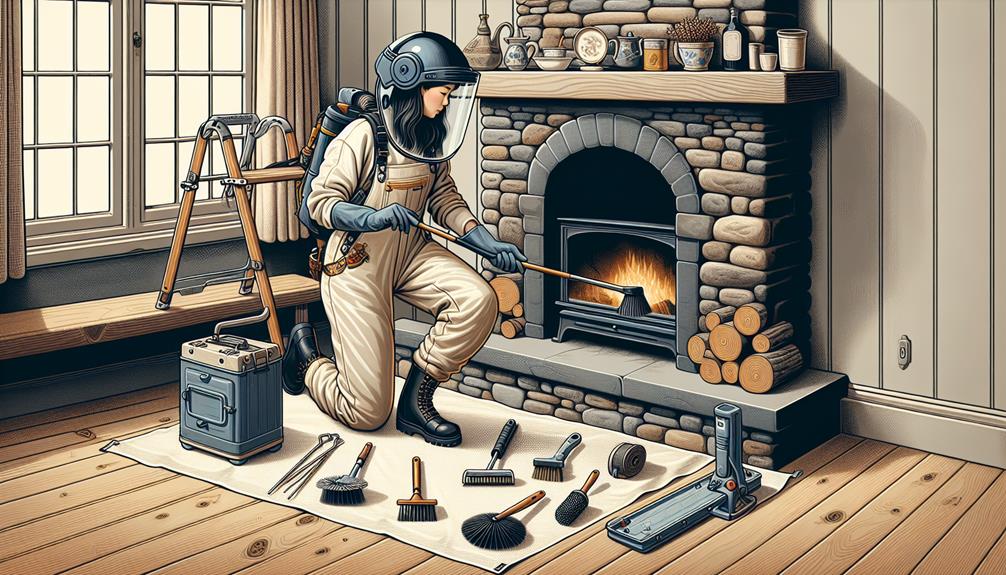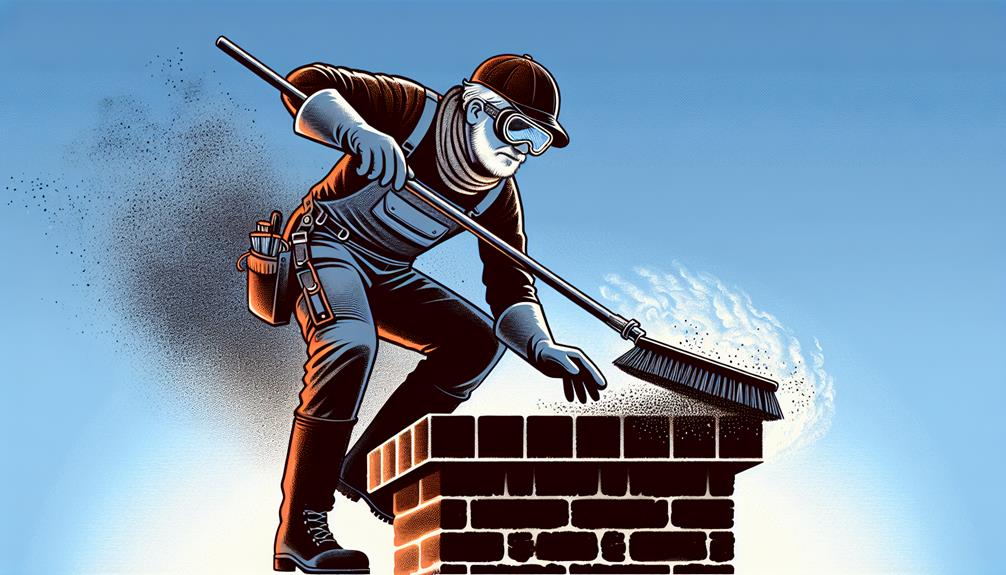When it comes to cleaning your woodburner and chimney, you need to make sure it’s safe and tidy. Sweeping your chimney with a woodburner involves a few important steps to prevent any dangers.
From taking safety precautions to using the right cleaning techniques, each step is essential for keeping your woodburner working well.
Follow these tips to sweep your chimney with a woodburner and keep your home cozy and secure.
Preparation and Safety Measures
To get ready for cleaning your chimney with a woodburner, clear the space around the stove and use a barrier to block off nearby areas. This is important for safety during the cleaning process. By getting rid of any possible dangers and keeping the soot and dirt contained, you create a safe zone for the job. Remember to secure coverings with tape to avoid spreading mess beyond the work area.
Wear protective gear like a dust mask, gloves, and goggles when sweeping the chimney. These items will shield you from breathing in harmful particles and protect your eyes and skin from debris. Make sure the room is well ventilated to avoid inhaling any harmful fumes.
Keep a fire extinguisher close by as a precaution in case of emergencies. Being ready for unexpected situations is crucial for maintaining a safe environment while cleaning your chimney with a woodburner.
Gather the required tools.
To clean your woodburner chimney effectively, you’ll need a chimney brush, rods, dust sheets, masking tape, and a fire spade shovel. These tools are crucial for a successful cleaning process. The chimney brush and rods help remove soot and creosote buildup, keeping your chimney clear and safe.
Dust sheets and masking tape protect your home from debris and soot. A fire spade shovel is handy for clearing larger debris from the fireplace.
Gather these tools before you start cleaning to make the process easier. With the chimney brush, rods, dust sheets, masking tape, and fire spade shovel on hand, you’re ready to clean your woodburner chimney effectively.
Insert Flexible Rods Into Flue
Insert the plastic rods into the chimney from the bottom. Make sure they’re firmly connected and slowly push them up the chimney. It is important to clean the entire chimney properly.
Here are some tips to help you:
- Connection: Check that the rods are securely attached to each other.
- Extension: Push the rods up slowly to prevent them from getting stuck.
- Pressure: Apply even pressure to keep making steady progress.
- Alignment: Keep the rods straight to avoid getting caught.
- Take your time. Be patient and insert the rods carefully to avoid problems.
Use Drill Attachment to Spin Rods
To efficiently clean your chimney, attach the drill accessory to spin the flexible plastic fiber rods. This spinning action helps remove creosote and debris from hard-to-reach areas in the chimney flue.
Here are the benefits and steps of using a drill attachment:
Benefits:
- Efficient cleaning
- Effective debris removal
- Reaches inaccessible areas
- Thorough chimney sweep
- Simplifies the cleaning process
Steps:
- Attach the drill accessory to the rods
- Insert the rods into the chimney flue
- Turn on the drill to spin the rods
- Slowly move the rods up and down the flue
- Repeat if necessary for a thorough cleaning
Using a drill attachment makes chimney sweeping easier and ensures a clean and safe chimney for your woodburner.
Monitor Progress and Cleaning
To make sure your chimney is clean, keep an eye on it regularly. Here are some tips to help you check and clean your chimney effectively:
- Look Outside: Check the outside of the chimney to see how clean it is.
- Use a Chimney Camera: Use a camera made for chimneys to see inside and make sure it’s clean.
- Add More Rods: Attach flexible rods as you clean to reach the whole chimney.
- Sweep Backwards: When pulling out the rods, sweep backwards to remove any leftover dirt.
- Contain Debris: Be careful to keep dust and dirt contained so it doesn’t spread in your home.
Tidy Up and Maintenance
After sweeping the chimney, clean the tools and equipment to keep them working well. Look for any damage or wear on the chimney and woodburner and fix it right away.
Check the chimney cap and spark arrestor for any blockages that could affect how the woodburner works. Make sure to tidy up the area to avoid spreading debris or soot.
Remember to schedule regular maintenance to keep the woodburner and chimney safe and efficient.
Frequently Asked Questions
Do You Sweep a Chimney With a Log Burner?
Sweep the chimney with a log burner to clean out creosote, prevent fires, and keep your heating system working well. Make sure to close off the area, wear protective gear like a dust mask, and use special tools designed for chimney cleaning.
How to Clean a Chimney With a Wood Stove?
To clean your wood stove chimney safely, follow these steps:
- Start with a cool stove
- Use the right tools
- Check for wear
- Gear up
- Keep the flue clear
How Often Should a Wood-Burning Chimney Be Swept?
You should clean your wood burning chimney once a year to get rid of creosote buildup and stay safe. If you use it a lot or burn wet wood, it’s best to clean it twice a year to prevent chimney fires and keep it working well.
How Do You Line a Chimney for a Wood-Burning Stove?
To line a chimney for a wood-burning stove, make sure the stainless steel liner fits properly. This helps the stove work better and keeps you safe. It also reduces the buildup of creosote and protects against heat and rust.
Conclusion
To sweep a chimney with a woodburner, you need the right tools, like a chimney brush and rods. Make sure to stay safe by wearing protective gear and working carefully.
It’s important to clean your chimney regularly to prevent buildup and maintain your woodburner’s efficiency. Keep an eye on your progress, and don’t forget to schedule routine maintenance.
By taking these steps, you can enjoy a cozy and safe fire in your home.











